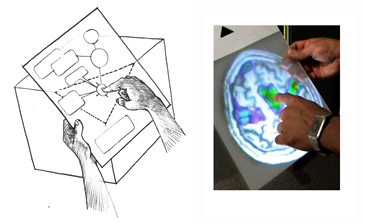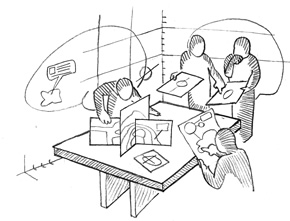Memory Blocks & Knowledge Voxels
Summary
Imagine being capable of storing/retrieving multi-media data from familiar things in the path to work: buildings, corners, trees or flowers... anything around you can be a "scaffold" to organize your personal data. This project is an alternative to the intangible "cloud", based on the idea of superimposing virtual 3d "data containers" onto real space.
More concretely, the "Memory Blocks/Knowledge Voxels" project aims at creating a format to represent, and an interface to browse dense databases based on the idea of superimposing volumetric virtual objects onto real space. The “method of loci” is a mnemonic technique that relies on human capacity to quickly and efficiently store new information on an imaginary 3d space (or “memory palace”): the goal of this research is to take this technique to the next level by making this “memory palace” an interpersonal 3d space to store and retrieve information instead of an individual, mental map. This will be done by merging spatial augmented reality, mixed reality and tangible interfaces developed in our lab. We first plan to make these volumetric Memory Blocks (MB) accessible simultaneously to several people in a large room (or even in public spaces); then, by using Web 2.0 technologies, we plan to make these MB the support of online collaborative bookmarking and information sharing.
 |
 |
The interface will work by superimposing Memory Blocks (that is, volumetric virtual objects) into a region of real physical space. These objects will be the receptacle, or scaffold,onto which multimedia information can be spatially organized. One can think of a “Memory Block” (MB) as a virtual library or bookshelf whose architecture or shape suffices to guide the search - instead of using a catalog or an alphabetic index. MBs may be used to store any kind of information (music album, literary references, contacts, etc) in an arbitrarily shaped 3d container - including public spaces. Users will be able to annotate, interact and navigate these objects by relying on their own physical frame of reference, as already demonstrated in our Volume Slicing Display system. They will be able to add notes and hyperlinks (manually or semi-automatically) onto 3d representations of the subject of study.
Publications
- Puig J., Perkis A., Pinel P., Cassinelli A., Masatoshi I., The neuroscience social network project, SIGGRAPH ASIA 2013 (poster), 19-22 Nov. 2013, Hong Kong. (2013) [PDF-1MB]
- Puig J., Perkis A., Hoel A.S., Cassinelli A., A-me: Augmented Memories, SIGGRAPH ASIA 2013, (art paper), 19-22 Nov. 2013, Hong Kong. (2013) [PDF-35MB]
- Summary description of the project (Memory Blocks & Knowledge Voxels, Kiban Research Project / Alvaro Cassinelli / 2012 to 2014) [PDF-1MB]



